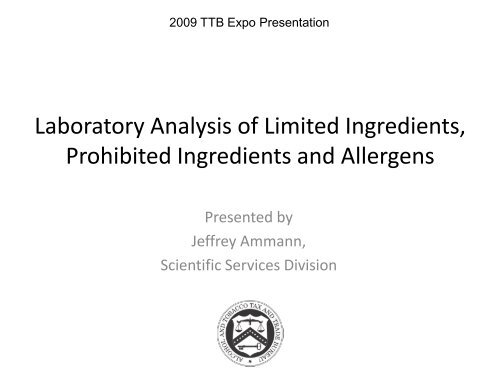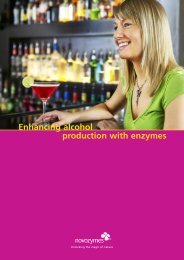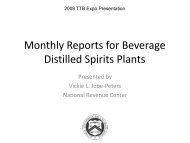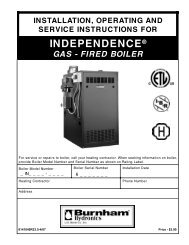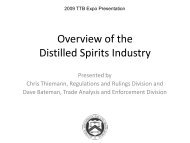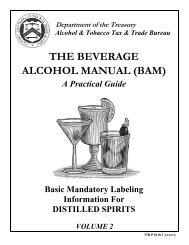Prohibited Ingredients - TTB
Prohibited Ingredients - TTB
Prohibited Ingredients - TTB
You also want an ePaper? Increase the reach of your titles
YUMPU automatically turns print PDFs into web optimized ePapers that Google loves.
2009 <strong>TTB</strong> Expo Presentation<br />
Laboratory Analysis of Limited <strong>Ingredients</strong>,<br />
<strong>Prohibited</strong> <strong>Ingredients</strong> and Allergens<br />
Presented by<br />
Jeffrey Ammann,<br />
Scientific Services Division
Overview<br />
• Background<br />
• <strong>Prohibited</strong> <strong>Ingredients</strong><br />
• Limited <strong>Ingredients</strong><br />
• Miscellaneous<br />
– Pesticides<br />
– Trace Metals Analysis<br />
– Ethyl Carbamate<br />
• Allergens<br />
– Background and regulations<br />
– Detection in alcoholic beverages
Background<br />
• On Jan 24 2003, Homeland Security Act<br />
established <strong>TTB</strong><br />
• Formerly associated with ATF<br />
• <strong>TTB</strong> remains in Treasury Department<br />
• ATF, now called ATFE, was transferred to the<br />
Justice Department
<strong>TTB</strong>’s Mission<br />
• To collect excise tax, to ensure products are<br />
labeled and marketed according to law, to<br />
protect the consumer, and to promote<br />
voluntary compliance
<strong>TTB</strong> Duties<br />
• Responsible for ensuring compliance with the<br />
Federal Alcohol Administration Act (FAA Act) and<br />
Internal Revenue Code (IRC)<br />
• Govern, amongst other things, the labeling of wines,<br />
distilled spirits, and malt beverages in interstate and<br />
foreign commerce<br />
• SSD provides comprehensive technical support to all<br />
<strong>TTB</strong> programs; SSD accomplishes its mission through<br />
four laboratories
Scientific Services Division<br />
Laboratories<br />
• Beverage Alcohol Laboratory<br />
– Beltsville, MD<br />
• Nonbeverage Products Laboratory<br />
– Beltsville, MD<br />
• Tobacco Laboratory<br />
– Beltsville, MD<br />
• Compliance Laboratory<br />
– Walnut Creek, CA<br />
Formally known as the Alcohol<br />
and Tobacco Laboratory when<br />
associated with ATF
<strong>Prohibited</strong> <strong>Ingredients</strong>
<strong>Prohibited</strong> <strong>Ingredients</strong><br />
• FDA establishes if an<br />
ingredient is prohibited for<br />
use in a food and/or<br />
beverage<br />
• In 1987, predecessor<br />
agency (ATF) entered MOU<br />
with FDA<br />
• <strong>TTB</strong> will consult with FDA<br />
regarding the necessity to<br />
label ingredients that pose a<br />
public threat<br />
• Regulations do not require a<br />
comprehensive list of<br />
ingredients<br />
• Examples of prohibited<br />
substances that may be<br />
associated with alcoholic<br />
beverages:<br />
– Thujone (21 CFR 172.510)<br />
– Coumarin (21 CFR 189.130)<br />
– Calamus and its derivatives (21<br />
CFR 189.110)<br />
– Tin-coated lead foil capsules for<br />
wine bottles<br />
(21 CFR 189.301)<br />
– Non-certified synthetic dyes<br />
– Stevioside
<strong>Prohibited</strong> <strong>Ingredients</strong> (Continued)<br />
Thujone Analysis in Distilled Spirits:<br />
• BAL has received an increased number of absinthe type products since the<br />
publication of IC 2007-5 (Use of the Term Absinthe for Distilled Spirits)<br />
• Monoterpenoid compound consisting of two isomers: alpha and beta<br />
• Found in artemesia (wormwood), white cedar, oak moss, tansy, yarrow<br />
• Developed a GC/MS screening method:<br />
– Scan mode<br />
– Capillary DB-Wax column, 0.25mm, 30m, 0.25um<br />
– Menthol as the internal standard, use alpha form for quantitation<br />
– LOD = 0.3 ppm, LOQ = 1 ppm<br />
• FDA regulation cites JAOAC 19, 120 (1936), with a LOD of 10 ppm<br />
• Samples with thujone levels lower than 10 ppm are considered thujonefree
<strong>Prohibited</strong> <strong>Ingredients</strong> (Continued)<br />
• Combined Thujone, Coumarin and beta-Asarone<br />
GC/MS Method:<br />
– Coumarin is an active ingredient of buffalo grass, tonka<br />
beans, sweet woodruff<br />
– beta-Asarone is an active ingredient of calamus<br />
– The goal was to combine these analytes into one GC/MS<br />
method<br />
– Menthol is the current internal standard for thujone (some<br />
samples contain menthol as an ingredient)<br />
• Cyclodecanone is being investigated as an alternative to menthol
<strong>Prohibited</strong> <strong>Ingredients</strong> (Continued)<br />
GC/MS Chromatogram of Thujone, Coumarin, Asarone and Internal Stds<br />
1800000<br />
Menthol<br />
8.35 min<br />
1500000<br />
1200000<br />
α-Thujone<br />
6.59 min<br />
Cyclodecanone<br />
9.29 min<br />
β-Asarone<br />
13.11 min<br />
Abundance<br />
900000<br />
600000<br />
Dihydrocoumarin<br />
12.88 min<br />
Coumarin<br />
13.91 min<br />
300000<br />
β-Thujone<br />
6.76 min<br />
0<br />
4 5 6 7 8 9 10 11 12 13 14 15 16<br />
Minutes
<strong>Prohibited</strong> <strong>Ingredients</strong> (Continued)<br />
• Coloring Material:<br />
– Added to impart a color which in not natural<br />
to the product<br />
– FD&C Certified (allowed) — Yellow #5 (tartrazine) must be<br />
declared on the label<br />
– Noncertified (allowed) — Examples are paprika, saffron,<br />
beet extract, caramel<br />
– Noncertified synthetic dye (prohibited)<br />
– Developed an HPLC method using DAD, in the process of<br />
validating this method, 26 total dyes in library — ODS<br />
column, phosphate buffer and methanol as mobile phase,<br />
gradient
<strong>Prohibited</strong> <strong>Ingredients</strong> (Continued)<br />
HPLC Chromatogram of Synthetic Dyes<br />
UV-Vis Spectrum of<br />
FD&C Yellow #5
<strong>Prohibited</strong> <strong>Ingredients</strong> (Continued)<br />
• Caramel in Straight Whisky (Standard of Identity):<br />
– Caramel may be added to a blended whisky to impart color<br />
– Synthetic caramel is typically produced by the dehydration of hexoses<br />
forming 5-hydroxymethylfurfural (5-HMF)<br />
• No pentoses, therefore no furfural (FF)<br />
– According to 27 CFR 5.23(a)(3)(iii) no material whatsoever may be<br />
added to a straight whisky<br />
• 5-HMF and FF formed naturally in the charring of new oak barrels<br />
– Developed an HPLC/DAD for the detection of 5-HMF and FF in whisky<br />
• Reversed-phase, C18 column, water and methanol as mobile phase, 275<br />
nm<br />
• Method is linear down to 1 ppm<br />
• An FF/5-HMF ratio of less than 2.0 indicates the addition of caramel
<strong>Prohibited</strong> <strong>Ingredients</strong> (Continued)<br />
HPLC Chromatogram of a Whisky Spiked with 5-HMF and FF<br />
UV-Vis Spectrum of 5-HMF
<strong>Prohibited</strong> <strong>Ingredients</strong> (Continued)<br />
• Stevioside and Rebaudioside A:<br />
– Found in extract of stevia rebaudiana<br />
– Sweetener often used in alcoholic beverages<br />
such as soju<br />
– Stevioside is prohibited for use in food or beverages, highly<br />
purified reb A recently approved by FDA<br />
– Developed an HPLC/DAD method for the detection of<br />
stevioside<br />
• Aminopropyl column, 250 mm x 4 mm, 5 um particle size<br />
• Acetonitrile/water mobile phase – isocratic<br />
• 205 nm
<strong>Prohibited</strong> <strong>Ingredients</strong> (Continued)<br />
HPLC Chromatogram of a Stevia Extract<br />
mAU<br />
300<br />
6.134<br />
Stevioside<br />
250<br />
200<br />
Rebaudioside C<br />
150<br />
Dulcoside A<br />
100<br />
8.606<br />
Rebaudioside A<br />
50<br />
0<br />
0 2.5 5 7.5 10 12.5 15 17.5<br />
min
Limited <strong>Ingredients</strong>
Limited <strong>Ingredients</strong><br />
• Typically, FDA establishes if an ingredient is<br />
limited for use in food and/or beverage:<br />
– Methanol<br />
– Sulfur dioxide<br />
– Flavoring substances<br />
• Quinine<br />
– Caffeine<br />
– Prussic acid
Limited <strong>Ingredients</strong> (Continued)<br />
• Methanol:<br />
– Byproduct of fermentation<br />
– FDA has set a safe level of methanol at 0.1% of methanol<br />
by volume in wine; any wine containing methanol in excess<br />
of this amount is deemed adulterated pursuant to the<br />
Federal Food, Drug and Cosmetic Act, 21 U.S.C.<br />
342(a)(2)(C) and 348 (Industry Circular 93-3)<br />
– FDA has established a safe level of methanol at 0.35% v/v<br />
in fruit brandy (FDA Administrative Guides 7401.01 and<br />
1701.01) — <strong>TTB</strong> uses this threshold<br />
for all distilled spirits
Limited <strong>Ingredients</strong> (Continued)<br />
• Methanol:<br />
– Currently use a capillary GC-FID method<br />
to quantify methanol levels in alcoholic beverages<br />
– DB-WAXETR, 30 m x 0.53 mm, 1 um film thickness<br />
– Linear range of 0.01-20% v/v, LOQ=0.01%<br />
– Method is also used for other fusel oils, PG, ethyl<br />
acetate, acetaldehyde, acetic acid, glycerol,<br />
benzaldehyde
Limited <strong>Ingredients</strong> (Continued)<br />
• Total Sulfur Dioxide:<br />
– Must be labeled if beverage contains<br />
10-350 ppm (27 CFR 4.22(b)(1), 4.32(e)<br />
and 7.22(b)(6))<br />
– Use modified aeration-oxidation method<br />
• Free and bound sulfite is converted to SO2, trapped in<br />
peroxide and converted to sulfuric acid, titrated with<br />
sodium hydroxide<br />
– Linear range of 5-500 ppm, LOD=1 ppm, LOQ=5<br />
ppm<br />
– Currently evaluating segmented flow analyzers
Limited <strong>Ingredients</strong> (Continued)<br />
• Quinine:<br />
– Limited to 83 ppm (21 CFR 172.575)<br />
– Use an HPLC/DAD method<br />
– Common marker for 5010 tax credit<br />
• Caffeine:<br />
– 21 CFR 182.1180 sets a tolerance of 0.02%<br />
(200 ppm)<br />
– Develop a UPLC/MS/MS method<br />
– C18 Acquity column, +ESI mode, multiple reaction<br />
monitoring<br />
– Linear range of 5-500 ppm, LOD=1 ppm, LOQ=5 ppm
Limited <strong>Ingredients</strong> (Continued)<br />
Caffeine MRM 195> 138 m/z<br />
Caffeine Full Scan
Limited <strong>Ingredients</strong> (Continued)<br />
• Prussic acid (cyanide):<br />
– Found in small quantities in the following flavor<br />
substances: cherry pits, elder tree leaves, peach<br />
leaves<br />
– Limited to 25 ppm (21 CFR 172.510)<br />
– 1 ppm in wine (27 CFR 24.246)<br />
– Use an ion chromatography method<br />
• LOD = 1ppm, LOQ = 3.5ppm<br />
• Waters Protein PAK DEAE 5 PW<br />
• High dilution (100:1)
Miscellaneous<br />
Pesticides, Trace Metals and<br />
Ethyl Carbamate
Pesticides in Wine<br />
• Analysis of Pesticides in Wine:<br />
– EPA sets regulations on the use and establishes tolerances on the<br />
residues of pesticides in foods and beverages<br />
– Tolerances have been established for grapes and wine grapes<br />
(cyazofamid, fluazinam, procymidone, vinclozolin)<br />
– No established pesticide residue levels in wine, use levels established<br />
for grapes as a guideline<br />
– If a pesticide is not registered with EPA, it is prohibited for use on<br />
crops (therefore prohibited for use in wine)<br />
– FDA and USDA monitor food sources to ensure that the limits are<br />
enforced<br />
– <strong>TTB</strong> has been screening wines since 1999 using a multiresidue GCMS<br />
method<br />
– Monitor ~155 pesticides in wine
• Pesticides:<br />
Pesticides in Wine (Continued)<br />
– Agilent 6890 GC equipped w/5973A mass selective<br />
detector and automatic liquid sampler<br />
– HP-5ms cap column: 0.25mm, 30m, 0.25um, constant<br />
pressure mode using retention time locking<br />
– SIM mode using three programs<br />
• Organohalogen<br />
• Organonitrogen<br />
• Organophosphorus<br />
– QC samples<br />
• 50 ppb standard<br />
• Water blanks and spikes<br />
• Wine blanks and spikes
Extracted Ion Chromatogram -Dimethomorph I and II<br />
Abundance<br />
Response<br />
5500<br />
5000<br />
Ion Exp% Act%<br />
301 100 100<br />
Response<br />
4500<br />
303 35.20 34.51<br />
Ion Exp% Act%<br />
4000<br />
3500<br />
3000<br />
2500<br />
2000<br />
1500<br />
165 41.40 41.72<br />
387 26.50 25.27<br />
Ion 301<br />
Ion 165<br />
Ion 303<br />
Ion 387<br />
301 100 100<br />
303 34.90 34.52<br />
165 42.90 44.06<br />
387 25.00 25.31<br />
1000<br />
500<br />
Time--><br />
0<br />
36.00 36.20 36.40 36.60 36.80 37.00 37.20 37.40 37.60 37.80 38.00 38.20 38.40
Trace Metal Analysis<br />
• Typically, FDA establishes if a trace metal is limited for use in a<br />
food and/or beverage:<br />
– Industry Circular 91-11 sets a tolerance of 300 ppb lead in wine<br />
– 27 CFR 24.246 sets a tolerance of 500 ppb copper in wine<br />
• If fined with copper sulfate<br />
– Inductively Coupled Plasma Mass Spectrometry<br />
• Direct analysis (dilute and shoot)<br />
• Low ppb LOQ<br />
• High throughput<br />
• Able to scan for 53 elements in one sequence<br />
• If <strong>TTB</strong> analyzes a sample, and the concentration of a trace<br />
metal appears to be high, we ask FDA for a health hazard<br />
evaluation
Ethyl Carbamate<br />
• Presence of EC in food and beverages is a public<br />
health concern for FDA and some foreign<br />
governments<br />
– Canada has imposed regulatory limits on EC<br />
– 30 ppb table wines, 100 ppb fortified wines, 150 ppb most<br />
distilled spirits, 400 ppb fruit brandies<br />
• EC formation in wine may be due to reaction of<br />
antimicrobial agent diethyl pyrocarbonate (DEPC)<br />
with ammonia<br />
– DEPC is now prohibited for use in wine
Ethyl Carbamate (Continued)<br />
• EC can also form due to the reaction of urea<br />
and ethanol in aqueous media<br />
• AOAC method involves liquid-liquid extraction<br />
with methylene chloride<br />
• Beverage Alcohol Laboratory has developed<br />
an optimized SPE method using GC/MS<br />
– Use deuterated EC as an internal standard
Ethyl Carbamate (Continued)<br />
Abundance<br />
Time--><br />
3400<br />
3200<br />
3000<br />
2800<br />
2600<br />
2400<br />
2200<br />
2000<br />
1800<br />
1600<br />
1400<br />
1200<br />
1000<br />
800<br />
600<br />
400<br />
200<br />
0<br />
Ion 62.00 (61.70 to 62.70): 1210013.D\data.ms<br />
Ion 64.00 (63.70 to 64.70): 1210013.D\data.ms<br />
d5-EC<br />
6.00 7.00 8.00 9.0010.0011.0012.0013.0014.0015.0016.0017.0018.0019.00<br />
Extracted ion chromatogram of a whisky sample<br />
spiked with deuterated ethyl carbamate internal standard<br />
EC
Conclusions<br />
• SSD applies modern analytical techniques in<br />
the analysis of limited and prohibited<br />
ingredients<br />
• Our method development program is<br />
modeled after AOAC OMA Program Manual
Food Allergens<br />
Background and Regulatory Issues
Food Allergies<br />
• Incident rate:<br />
– ~1.5% for adults<br />
– ~6-8% for children under 3<br />
• Food Allergen Labeling and Consumer Protection Act<br />
of 2004 (FALCPA) requires that food product label<br />
declare if a “major food allergen” is present, as well<br />
as ingredients that contain protein derived from<br />
major food allergens<br />
• Plain, common language of the “BIG 8”<br />
– Milk, egg, fish, wheat, tree nut, peanut, soy, shellfish<br />
• The allergen is a protein
• Immunological:<br />
Food Allergy/Intolerance/<br />
Hypersensitivity<br />
– Antibody mediated (food allergy)<br />
– Cell mediated (celiac disease)<br />
• Non-immunological:<br />
– Metabolic (lactose intolerance)<br />
– Toxicological (scombroid poisoning)
<strong>TTB</strong> and FALCPA<br />
• FALCPA does not directly apply to alcoholic<br />
beverage labels<br />
• The House Committee on Energy and<br />
Commerce called for <strong>TTB</strong> to work with FDA on<br />
appropriate labeling<br />
• Clear intent in the House Committee Report is<br />
that <strong>TTB</strong> issue regulations similar to FALCPA<br />
standards
Food Allergens and Regulations<br />
• On April 29, 2005, <strong>TTB</strong> published an ANPRM titled<br />
“Labeling and Advertising of Wines, Distilled Spirits<br />
and Malt Beverages; Request for Public Comment”<br />
– Broad announcement to public<br />
• Invited comments on labeling, calorie and<br />
carbohydrate claims, serving facts, ingredient<br />
labeling and allergen labeling<br />
• Consumers, interest groups, trade associations,<br />
industry, other members of the public<br />
• Received 18,000 comments, 50 of which concerned<br />
allergens
Comments from ANPRM<br />
• Industry cost versus consumer benefit<br />
• Requirement of a full list of ingredients in<br />
addition to the allergen label<br />
• Separate labeling when an allergen appears as<br />
part of a brand name<br />
• Labeling of processing and fining agents<br />
• Setting of thresholds<br />
• Harmonization with foreign government<br />
requirements
Comments from ANPRM (Continued)<br />
• Comments on Labeling When the Allergen<br />
Appears as Part of Brand Name:<br />
– “Creek’s Wheat Beer”<br />
– “Wheat Creek Lager”<br />
– Is the brand name imparting information about<br />
the presence of an allergen<br />
– Best policy to have one standard format,<br />
regardless of the brand name
Comments from ANPRM (Continued)<br />
• Labeling of processing and fining agents:<br />
– FDA defines a processing aid as an “incidental<br />
additive” and must conform to FALCPA<br />
– “Processed with” versus “contains”<br />
– “May contain” is unclear and misleading for a<br />
processing aid that was intentionally added
Comments from ANPRM (Continued)<br />
• Harmonization with Foreign Government<br />
Requirements:<br />
– On Nov 25, 2003, the European Commission<br />
implemented a provisional exclusion for 8 major<br />
uses of food allergens in alcoholic beverages (end<br />
Nov 27, 2007)<br />
– Distillates made from cereal with gluten,<br />
whey and nuts<br />
– Lysozyme, albumin, fish gelatin (isinglass) and<br />
casein products used in wine<br />
– Nuts used as flavor in distilled spirits
Food Allergens and Regulations<br />
• Of the comments <strong>TTB</strong> received on allergens, vast<br />
majority favored mandatory labeling<br />
• As a result, <strong>TTB</strong> has published both an NPRM and an<br />
interim rule involving a period of voluntary labeling<br />
of food allergens<br />
• On July 26, 2006, <strong>TTB</strong> published an NPRM soliciting<br />
comments regarding the adoption of mandatory<br />
food allergen labeling for wines, distilled spirits and<br />
beer<br />
– Comment period extended to Dec 26, 2006<br />
– Focused announcement to public
Food Allergens and Regulations (Continued)<br />
• <strong>TTB</strong> published interim rule T.D. <strong>TTB</strong>-53,<br />
71 FR 42260, which sets forth standards for optional<br />
allergen labeling statements<br />
– Any reference made to allergens must declare all major<br />
food allergens used in the production of the beverage,<br />
including fining or processing agents<br />
– An allergen declaration must consist of the word<br />
“Contains” followed by a colon and the name of the food<br />
source from which each major food allergen is derived.<br />
For example, a declaration could be “Contains: milk and<br />
egg.”
Food Allergen Labeling – Exemptions<br />
• Highly refined oil<br />
• Exemption under the FD&C Act:<br />
– Petition to exempt an ingredient (180 days; FDA<br />
has rejected one; one petition pending)<br />
– Notification to exempt an ingredient (90 days; FDA<br />
has objected to all seven notifications submitted)<br />
• Exemption from <strong>TTB</strong> regulations
Petition Process (if Labeling is Mandatory)<br />
• Potentially can petition <strong>TTB</strong> to exempt an alcoholic beverage<br />
from food allergen labeling if demonstrate:<br />
– Product does not cause an allergic response that poses risk to health<br />
— Burden is on the petitioner to provide scientific evidence<br />
– Product does not contain an allergenic protein, even though a major<br />
food allergen was used — Burden is on the petitioner to provide<br />
scientific evidence<br />
• <strong>TTB</strong> will focus on products not ingredients<br />
• Lab must develop methods to verify the presence or absence<br />
of food allergens in alcoholic beverages
Food Allergens<br />
Detection and Evaluation
Analytical Methods to Detect Food Allergens<br />
• Polymerase Chain Reaction:<br />
– Expensive<br />
– Need specific primers<br />
– Specific<br />
• Mass Spectrometry:<br />
– Expensive<br />
– Not high throughput, technically demanding<br />
– Specific<br />
• Enzyme Linked Immunosorbant Assay:<br />
– Inexpensive ($300-$500/kit, up to 96 wells)<br />
– Amenable to high throughput
Fining Agents Used for Wine<br />
• Used to achieve clarity, improve color<br />
and flavor:<br />
– Bentonite (clay), 2-8 lbs/1,000 gal<br />
– Agar (polysaccharides)<br />
– Synthetic polymers (PVPP), 1-6 lbs/1,000 gal<br />
– Kieselsol (silicon dioxide),
Protein Fining Agents for Wine<br />
• Milk:<br />
– Principle protein is casein, soluble at high pH<br />
– Usually use potassium caseinate (or cellulose adduct –<br />
VINPUR)<br />
– White wine clarifier, 0.2-2 lbs/1,000 gal<br />
• Gelatin:<br />
– Protein in connective tissue<br />
– Soften red wines, 0.2-0.8 lb/1,000 gal<br />
• Isinglass:<br />
– Fish protein, 0.2-0.5 lb/1,000 gal<br />
• Egg:<br />
– Egg whites, 3 egg whites/60 gal
Egg Allergens<br />
• Egg whites contain 9-11% protein, most allergenic<br />
proteins found in egg white:<br />
– Ovomucoid (11% of egg white protein)<br />
– Ovalbumin (54%)<br />
– Ovotransferrin (12%)<br />
– Lysozyme (3.5%)<br />
• Allergenic potential for egg yolk is only moderate<br />
• Evaluate commercially available ELISA kits for egg<br />
protein in wine
ELISA Technology<br />
• Enzyme-linked immunosorbent assay<br />
• Assay proteins<br />
• Utilizes antibodies (monoclonal or polyclonal)<br />
immobilized on polystyrene — Capture antibody<br />
• Second antibody is labeled with an enzyme<br />
(sandwich type) — Detector antibody<br />
• Enzyme reacts with substrate, then add chromagen<br />
followed by stopping reagent<br />
• Color detected by plate reader; intensity is<br />
quantitated
Egg Protein Assay ELISA Kits<br />
• Neogen-Veratox® Quant Egg Allergen Test<br />
– Wine validation method<br />
• Biopharm-Ridascreen® Ei/Egg Protein<br />
– Antibodies specific to egg white protein<br />
• Tepnel-Egg Assay Kit<br />
– Polyclonal antibody to ovomucoid<br />
• Morinaga Institute Egg Protein<br />
ELISA Kit<br />
– Specific to ovalbumin
Egg Protein Assay ELISA Kits (Continued)<br />
• Each kit supplied with STD, but<br />
each kit STD is different<br />
– Tailored for maximum binding to<br />
kit antibody<br />
– Antibodies are usually<br />
proprietary<br />
– Used a commercially available<br />
spray-dried whole egg powder<br />
(reference material obtained<br />
from S. Hefle, 48.9% total<br />
protein)<br />
• Must dilute concentrated<br />
samples to fall in range of<br />
calibration curve<br />
– Each time run is performed,<br />
need calibration curve of kit<br />
standards and run in duplicate
Wine Samples<br />
• Obtained commercially available wine samples<br />
directly from the manufacturer through our Trade<br />
Investigation Division<br />
• Nine red wine samples:<br />
– Cabernet, Pinot, Merlot, Zinfandel, Syrah<br />
– All fined with egg except for Syrah, used as control and<br />
spiked with reference material<br />
• One white wine sample:<br />
– Chardonnay<br />
– Not fined with egg, used as control and spiked with<br />
reference material
Egg Kit Responses to Wine Spiked with RM<br />
Kit Responses to a 10 ppm spiked wine sample<br />
60<br />
57.3<br />
Response converted to<br />
Whole Egg Powder (ppm)<br />
50<br />
40<br />
30<br />
20<br />
10<br />
7.9<br />
14.3<br />
22.7<br />
0<br />
Morinaga<br />
Tepnel<br />
Neogen<br />
R-Biopharm
Wine Fined with Eggs<br />
• All kits detected egg protein in spiked<br />
wine matrices<br />
• None of the kits detected egg protein<br />
in fined samples<br />
• Limit of Quantitation:<br />
– Neogen, 2.5 ppm, (1 ppm with wine method)<br />
– R-Biopharm, 2 ppm<br />
– Tepnel, 0.5 ppm
Response of<br />
Egg RM vs. Time<br />
Henningsen Time Study<br />
Concentration of Whole Egg Powder (ppm)<br />
120.0<br />
100.0<br />
80.0<br />
60.0<br />
40.0<br />
20.0<br />
0.0<br />
0 20 40 60 80 100 120 140 160<br />
Time (hours)
Conclusions on<br />
Egg Kits<br />
• ELISA technology evaluated<br />
• Egg reference material spiked in wine matrices<br />
was detected by all kits; however, wide<br />
disparity in responses<br />
• Response to egg reference material shown to<br />
degrade over time in wine<br />
• Results from ELISA test will not be sufficient<br />
for allergen label claim exemptions
Wheat Allergens<br />
• Gluten is group of cereal proteins comprised<br />
of 50% glutelins and 50% prolamines –<br />
prolamines are soluble in<br />
40-70% aqueous ethanol<br />
• Cereals are used as source for malt beverages<br />
– barley<br />
• Other cereal adjuncts may be used in brewing<br />
process – corn, oats and wheat
Gluten ELISA Kits<br />
• Gliadin, a wheat prolamine, involved with<br />
allergies (antibody response) and intolerances<br />
(cell-mediated response)<br />
• Is this protein in malt beverages<br />
• Evaluate commercially available<br />
ELISA-based kits for gluten detection in malt<br />
beverages<br />
• FDA has authority to issue guidelines to<br />
establish a definition of “gluten-free”
Analyzed Malt Beverage Samples<br />
• 3 Domestic<br />
• 2 Domestic light<br />
• 3 Import<br />
• 2 Import light<br />
• 1 Stout<br />
• 1 Lager<br />
• 1 Ale<br />
• 1 Nonalcoholic<br />
• 2 Flavored malt<br />
beverage<br />
• 2 Wheat beer
Gluten Assay ELISA Kits<br />
• Neogen-Veratox® Quant Gliadin Test:<br />
– Proprietary<br />
• R-Biopharm-Ridascreen® Fast Gliadin:<br />
– R5 Antibody (produced by Mendez in Spain)<br />
– Peptides containing the QQPFP sequence are<br />
recognized by R5 antibody<br />
– R-Biopharm now has a competitive ELISA<br />
• Recognizes gliadin epitope; however, results are in<br />
peptide equivalents, not in ppm gluten
Gluten Assay ELISA Kits (Continued)<br />
• Tepnel- Gluten Assay Kit:<br />
– Skerritt Antibody<br />
• Each kit supplied with STD, but each kit STD is<br />
different:<br />
– Tailored for maximum binding to kit antibody<br />
– Variables include: ionic strength, carrier proteins,<br />
enhanced solubility
Other Gluten ELISA Kit Issues<br />
• Expiration date<br />
• Must be stored at 4° C<br />
• Specificity:<br />
– Kits only detect gliadin, celiac patients may<br />
also react to glutelins<br />
• What to use as reference material<br />
• Limit of Quantitation:<br />
– 5-10 ppm for all kits evaluated
Sample Preparation<br />
• Extract malt beverage in<br />
40-70% EtOH solution<br />
usually 10:1<br />
• Dilute even further in<br />
sample diluent for a<br />
total of 400-500:1<br />
dilution<br />
• Sample preparation<br />
issues:<br />
– Degassing<br />
– Extracting in ethanol<br />
– Minimizing non-specific<br />
binding<br />
• Tannin binding solution<br />
– Heat treated samples<br />
• Pre-extraction cocktail
Results<br />
R-Biopharm Degassing Experiment<br />
Gluten conc. (ppm)<br />
500<br />
450<br />
400<br />
350<br />
300<br />
250<br />
200<br />
150<br />
100<br />
50<br />
0<br />
Sample 17 Sample 18<br />
Wheat Beer<br />
Not Degassed<br />
Degassed
Results (Continued)<br />
Gluten Conc (ppm)<br />
70<br />
60<br />
50<br />
40<br />
30<br />
20<br />
10<br />
0<br />
R-Biopharm Ethanol (aq) Extraction Experiment<br />
Samp #1 Samp #4 Samp #6 Samp #11 Samp #15<br />
Malt Beverage<br />
Extracted with 60% EtOH<br />
Not Extracted
Results (Continued)<br />
Well-to-Well Reproducibility (Lager)<br />
14<br />
12<br />
10<br />
ppm<br />
8<br />
6<br />
4<br />
2<br />
0<br />
1 2 3 4 5 6 7 8<br />
Run #<br />
Lager Avg Gluten conc= 10.4 ppm
Results (Continued)<br />
Comparison of Gluten Conc in Malt<br />
Beverages by Various Kits (no<br />
Tannin Extraction Soln)<br />
Gluten Conc (ppm)<br />
35<br />
30<br />
25<br />
20<br />
15<br />
10<br />
5<br />
0<br />
1 2 3 4 5 6 7 8 9 10 11 12 13 14 15 16<br />
Malt Beverage<br />
Neogen Tepnel R-Biopharm
Results (Continued)<br />
Tepnel Kit-to-Kit Comparison Using Tannin<br />
Extraction Solution<br />
250<br />
Gluten Conc (ppm)<br />
200<br />
150<br />
100<br />
50<br />
0<br />
KIT 1 KIT 2 KIT 3<br />
ELISA KIT<br />
Import Light Stout Lager
Results (Continued)<br />
Gluten Conc (ppm)<br />
45<br />
40<br />
35<br />
30<br />
25<br />
20<br />
15<br />
10<br />
5<br />
0<br />
R-Biopharm Kit-to-Kit Comparison Using Tannin<br />
Extraction Solution<br />
Kit 1 Kit 2 Kit 3<br />
ELISA KIT<br />
Import Light Stout Lager
Results (Continued)<br />
Neogen Kit-to-Kit Comparison Using Cocktail Solution<br />
90<br />
80<br />
Gluten Conc (ppm)<br />
70<br />
60<br />
50<br />
40<br />
30<br />
20<br />
10<br />
0<br />
Kit 1 Kit 2 Kit 3<br />
ELISA KIT<br />
Import Light Stout Lager
Non-ELISA Detection of Food<br />
Allergens<br />
Gluten<br />
Prolamine<br />
Glutelins<br />
Wheat Barley Oat Rye<br />
Gliadins Hordeins Avenins Secalins<br />
LMW<br />
Glutenins<br />
HMW<br />
Glutenins<br />
• Mol Wt 30-50kDa<br />
• Rich in proline and glutamine<br />
(20%,35%)<br />
• Monomeric polypeptide chain<br />
• Mol Wt 15-150kDa<br />
• Many intra- and intermolecular<br />
disulfide bonding due to high<br />
cysteine residues<br />
• 13% proline, 30% glutamine
Evaluation of Malt Beverage<br />
Protein Profiles via Immunoblot<br />
Human IgA<br />
# 14224<br />
4 3 2 1 m<br />
Human IgE<br />
# 12352<br />
4 3 2 1 m<br />
• Evaluated 4 beers: 1)<br />
wheat, 2) lager, 3) stout, 4)<br />
light; (m=marker)<br />
• Membrane evaluated for<br />
IgA, no binding<br />
• Membrane evaluated for<br />
IgE, only high MW binding<br />
(glutelins)<br />
• Will require very sensitive<br />
techniques
Protein Detection by Mass<br />
Spectrometry<br />
• May detect hydrolyzed or denatured proteins<br />
• Very selective in determining the grain origin of<br />
proteins<br />
• Quantification capabilities with triple quadrupole<br />
detectors<br />
• Protein Sequencing and Identification<br />
– Protein Purification<br />
– Proteolitic Digest (Trypsin)<br />
– Mass Spectrometric Analysis of Tryptic Digest<br />
– Protein Identification by Database Searching
Peptide Sequencing<br />
50ug/ml Gluten digest 30% EtOH<br />
kjs_Gluten_041107_2 MaxEnt 3 37 [Ev61619,It50,En1] (0.050,200.00,0.200,1400.00,2,Cmp)<br />
100<br />
9: TOF MSMS 766.96ES+<br />
(307.25) Q Q Q L (709.46) yMax<br />
229.16<br />
823.45<br />
b1<br />
y4<br />
%<br />
595.31<br />
257.13<br />
370.21<br />
710.41<br />
b<br />
y3<br />
467.26 580.31<br />
611.35<br />
226.12<br />
209.10<br />
806.42 824.54 922.53<br />
995.41 1189.44 1304.67 1419.64<br />
1498.52<br />
1575.75<br />
0<br />
M/z<br />
100 200 300 400 500 600 700 800 900 1000 1100 1200 1300 1400 1500 1600<br />
MSMS spectrum of the fragments of 766.96 m/z ion extracted from one<br />
of the gluten digest peak eluting at 40.89 min. The dotted lines represent<br />
sequences and peptide masses obtained using the peptide sequence<br />
tag analysis.
Conclusions<br />
• <strong>TTB</strong> mandated by Congress to enforce FALCPA<br />
• Mandatory food allergen labeling is proposed<br />
but not yet implemented<br />
• Petitions for label exemptions possible<br />
• ELISA technology evaluated<br />
• All kits detected gluten in malt beverages,<br />
quantitation difficult<br />
• Results from ELISA test will not be sufficient for<br />
allergen label claim exemptions<br />
• <strong>TTB</strong> is evaluating the use of mass spectrometry to<br />
identify and quantitate allergens in alcoholic<br />
beverages
Web Sites<br />
www.ttb.gov<br />
http://www.cfsan.fda.gov<br />
http://ecfr.gpoaccess.gov<br />
http://www.farrp.org/index.htm
Contact Information<br />
Beverage Alcohol Laboratory<br />
– Phone: (240) 264-1596<br />
– Mail: Beverage Alcohol Laboratory<br />
6000 Ammendale Rd<br />
Beltsville, MD 20705


